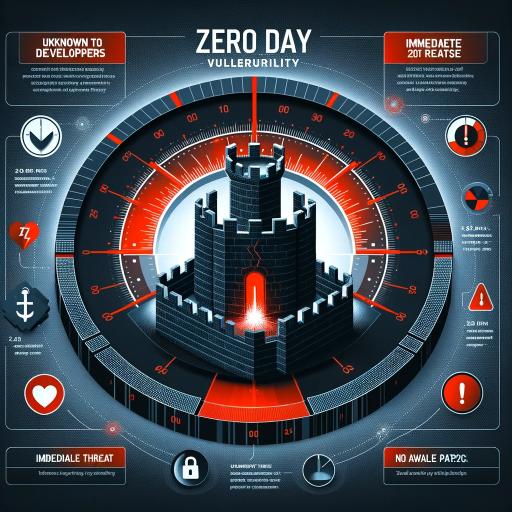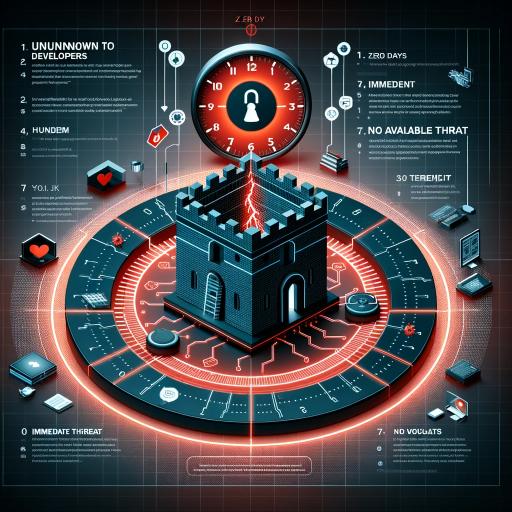A “Zero Day Vulnerability” refers to a security flaw in software that is unknown to the software developers or vendors at the time of discovery.
This term underscores the fact that the developers have “zero days” to fix the issue since they were unaware of the flaw before it was identified.
These vulnerabilities are particularly dangerous because there is often no ready-made solution or patch available at the time of discovery, leaving systems exposed to potential exploitation by hackers or malicious entities.
Detection and Challenges
Detecting zero-day vulnerabilities is a complex challenge due to their unknown and unexpected nature. This process often involves:
- Advanced Monitoring Techniques: Employing sophisticated software that uses anomaly detection, AI, and machine learning to identify irregular patterns indicative of potential exploits.
- Security Research and Ethical Hacking: Leveraging the skills of security professionals and ethical hackers to proactively search for and identify vulnerabilities.
- Collaborative Information Sharing: Engaging in cybersecurity communities for collective intelligence on emerging threats and vulnerabilities.
- Rapid Response and Patch Management: Once identified, there’s an urgent need for swift development and deployment of fixes to prevent exploitation, requiring a well-coordinated effort between developers, security teams, and end-users.
- Continuous Security Training: Keeping IT staff and users informed about the latest security practices and potential threats.
This section demonstrates the necessity of a comprehensive approach combining technology, expertise, and collaboration to effectively detect and respond to zero-day vulnerabilities.
Zero-day vulnerabilities are a significant issue because they represent security holes in software systems that are unknown to the software vendor or the public until they are exploited. Since these vulnerabilities are previously unidentified, there are no existing patches or security measures in place to prevent the exploitation.
This makes zero-day vulnerabilities particularly dangerous as they can be exploited to gain unauthorized access or cause damage before developers have a chance to fix them. Their unpredictability and lack of immediate detectable signatures make them challenging for security systems to identify and defend against.
Advanced Monitoring Techniques
These techniques involve deploying sophisticated cybersecurity tools that utilize artificial intelligence and machine learning. For example, anomaly detection algorithms analyze normal operational patterns and flag deviations, which could indicate a cyber attack. AI-driven systems can learn from previous incidents and adapt to recognize new types of threats.
However, these advanced methods can sometimes produce false positives, leading to unnecessary alerts. The solution lies in continuously refining AI models and integrating human oversight to assess and interpret alerts accurately.
Additionally, advanced monitoring systems can struggle with the vast and complex data environments of large organizations. This issue can be addressed by implementing scalable solutions and ensuring these systems are tailored to the specific needs of the organization.
Through continuous improvement and adaptation, these advanced monitoring techniques become invaluable tools in the early detection of zero-day vulnerabilities.

Security Research and Ethical Hacking
This aspect involves professionals who proactively seek out vulnerabilities in systems before they can be exploited maliciously. Ethical hackers use penetration testing to simulate cyberattacks under controlled conditions, uncovering weaknesses.
An issue here is the potential for ethical hackers to inadvertently disrupt normal operations. To mitigate this, ethical hacking should be carefully planned and executed in coordination with the organization’s IT department. Furthermore, as ethical hacking can’t cover all possible scenarios, it should be part of a broader security strategy, supplemented with other measures like regular security audits and advanced monitoring systems.
Collaborative Information Sharing
This approach emphasizes the sharing of cybersecurity intelligence among organizations, researchers, and security experts. Platforms like CERT (Computer Emergency Response Teams) and industry-specific security forums allow for the dissemination of information about new threats, including zero-day vulnerabilities.
Challenges in this area include ensuring the reliability of shared information and protecting sensitive data. Solutions involve establishing trusted networks and protocols for secure information sharing. This collaborative effort is crucial in building a robust defense against emerging cyber threats.
Rapid Response and Patch Management
This area focuses on the swift action needed once a zero-day vulnerability is identified. It involves developing, testing, and deploying patches to secure systems against the exploit.
Challenges include quickly mobilizing development and security teams, ensuring patches don’t introduce new vulnerabilities, and effectively distributing updates.
The solution lies in having a well-prepared incident response plan, efficient communication channels, and robust testing protocols. This rapid response is essential to minimize the window of opportunity for attackers and protect system integrity.
Continuous Security Training
“Continuous Security Training” focuses on the importance of keeping IT staff and users updated on the latest cybersecurity practices and threats. This involves regular training sessions, security awareness programs, and updates on recent vulnerabilities and attack methods.
The main challenge is keeping the training material relevant and engaging. Solutions include interactive training modules, real-world case studies, and continuous feedback mechanisms. Effective training ensures that everyone is vigilant and prepared to recognize and respond to security threats, forming a critical line of defense against cyber attacks.

Examples
Stuxnet incident
The Stuxnet attack on Iran’s Natanz nuclear facility in 2010 was a groundbreaking moment in cyber warfare. Designed as a highly sophisticated malware, it specifically targeted the facility’s Siemens industrial control systems. Utilizing multiple zero-day vulnerabilities, Stuxnet was able to infiltrate and manipulate these systems without detection.
The primary goal of Stuxnet was to disrupt Iran’s uranium enrichment process. It achieved this by causing the centrifuges to spin uncontrollably, leading to physical damage. However, to the operators and the monitoring systems, everything appeared normal, a factor that significantly contributed to the success and stealth of the operation.
This attack was significant not just in its technical sophistication but also in its geopolitical implications. It was the first known instance of a digital weapon being used by one nation to cause physical destruction in another, marking a new era in international relations and warfare.
The success of Stuxnet in exploiting zero-day vulnerabilities lay in its precise design and the fact that it targeted very specific industrial control systems. This specificity reduced the chances of early detection and allowed the malware to achieve its intended effect before being discovered.
Furthermore, the use of zero-day vulnerabilities meant that there were no existing patches or defenses against the exploits. This aspect of the attack highlighted the critical importance of cybersecurity in national defense and infrastructure protection, underscoring the need for continuous monitoring, regular updates, and proactive defense strategies against potential cyber threats.
Stuxnet’s impact went beyond the immediate physical damage it caused. It opened a global dialogue on the ethics, legality, and potential consequences of cyber warfare. This incident became a case study in cybersecurity circles, emphasizing the need for robust security measures and international cooperation in cyber defense.
More info on this https://en.wikipedia.org/wiki/Stuxnet
More examples:
- Microsoft Windows SMBv3 Protocol Vulnerability (2020): This flaw allowed attackers to execute arbitrary code on a target server or client.
- Adobe Flash Player Zero-Day (2018): Exploited in targeted attacks, it allowed attackers to take control of an affected system.
- Apple Safari Zero-Day (2019): Discovered at a hacking contest, this vulnerability could allow unauthorized website access to MacOS and iOS devices.
- WannaCry Ransomware Attack (2017): This global cyberattack exploited a zero-day vulnerability in Windows OS known as EternalBlue. It affected over 200,000 computers across 150 countries, encrypting data and demanding ransom payments.
- Adobe Flash Player Zero-Day (2018): A critical zero-day vulnerability was discovered in Adobe Flash Player, which allowed attackers to execute arbitrary code on the victim’s computer. It was used in targeted attacks against users in several countries.
- Google Chrome Zero-Day Exploit (2019): Google reported a zero-day vulnerability in its Chrome browser that was actively being exploited. The vulnerability allowed attackers to execute arbitrary code and take control of affected systems.
- SolarWinds Supply Chain Attack (2020): While not a traditional zero-day exploit, this sophisticated attack involved hackers compromising the infrastructure of SolarWinds, a popular network management software, which then allowed them to infiltrate numerous government agencies and private companies.




